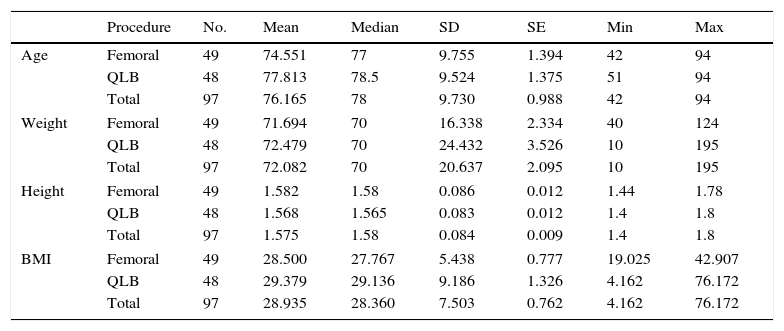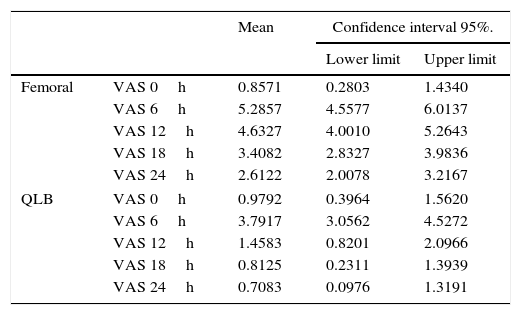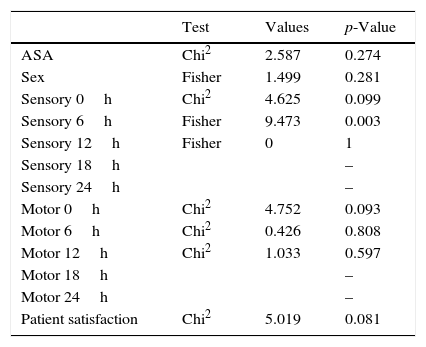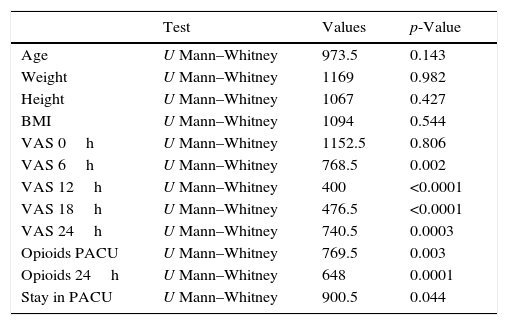A double-blind randomised controlled trial was conducted to compare the analgesic effect of the transversus abdominis plane block posterior approach or the quadratus lumborum block I versus femoral block, both ultrasound-guided.
Material and methodsProspective study with parallel groups with 104 patients with neck of femur fracture undergoing hemiarthroplasty (although 7 participants did not finish the study). The inclusion criteria were patients older than 65 years old, ASA I–III status, who required and gave their consent for hemiarthroplasty. The exclusion criteria were patients with known allergy to local anaesthetics, mental disability, peripheral neuropathy, a coagulopathy disorder, and those patients who received morphine, or a block was performed previous to the surgery. Each patient received one block followed by a spinal anaesthetic technique, performed by the anaesthetist. Pain was measured using a visual analogue score, sensory blockade using cold spray, and motor blockade, evaluating the leg movement. These were compared on arrival in recovery and at 6, 12, 18, and 24h later. Total opioid amount administered in 24h, duration of stay in post-anaesthesia care unit, patient satisfaction, and adverse effects were also recorded.
ResultsA lower visual analogue score was observed in the quadratus lumborum block group at 6, 12, 18 and 24h (3.7, 1.4, 0.8, 0.7 versus 5.2, 4.6, 3.4, 2.6 in the femoral group, p<.01). Opioid use in 24h was lower in this group (9.7 versus 16.9mg in the femoral group, p<.01). The sensory and motor blockade, satisfaction, and adverse effects, were similar in both groups.
ConclusionsQuadratus lumborum block is an effective analgesic option to be used in patients with neck of femur fracture. More clinical trials are required to validate this.
Ensayo clínico aleatorizado, a doble ciego, comparando la eficacia analgésica del bloqueo del plano transverso abdominal en su abordaje posterior o bloqueo del cuadrado lumbar tipo I versus el bloqueo femoral, ambos guiados con ultrasonidos.
Material y métodosEstudio prospectivo de grupos paralelos con 104 pacientes con fractura de cuello de fémur, que fueron intervenidos mediante hemiartroplastia, aunque solo 97 participantes finalizaron el estudio. Los criterios de inclusión fueron pacientes mayores de 65 años, ASA I-III, que requirieron y firmaron el consentimiento informado para cirugía de hemiartroplastia. Los criterios de exclusión englobaron alergia conocida a anestésico local, discapacidad mental, neuropatía periférica, coagulopatía y a aquellos pacientes que recibieron morfina o a quienes se les realizó un bloqueo previo a la cirugía. Los pacientes recibieron uno de los 2 bloqueos seguidos de anestesia raquídea, llevada a cabo por un anestesiólogo. El dolor fue medido con la escala visual analógica, el bloqueo sensitivo fue valorado con espray frío, el bloqueo motor fue evaluado con la movilización de la pierna. Estos datos fueron recogidos a la llegada a la reanimación y a las 6, 12, 18 y 24h más tarde. También se anotó el consumo de opioides a las 24h, la duración de la estancia en reanimación, la satisfacción del paciente y los efectos adversos del bloqueo.
ResultadosSe mostraron unos valores de dolor menores medidos a 6, 12, 18 y 24h en el grupo cuadrado lumbar (3,7; 1,4; 0,8; 0,7 versus 5,2; 4,6; 3,4; 2,6 en el grupo femoral) con p<0,01. El consumo de opioides fue menor en este grupo (9,7 versus 16,9mg en el grupo femoral), con p<0,01. El bloqueo sensitivo y motor, la satisfacción y los efectos adversos fueron similares en ambos grupos.
ConclusionesEl bloqueo cuadrado lumbar es una opción analgésica eficaz para pacientes con fractura de cuello de fémur. Se requiere de más ensayos clínicos para su validación.















